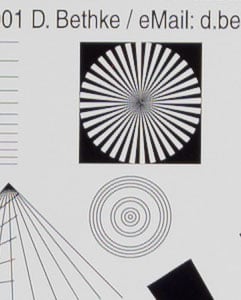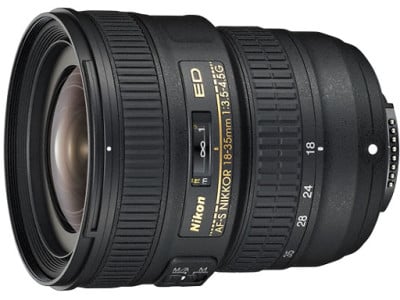Nikon 18-35mm f3.5-4.5G review
-
-
Written by Thomas
Quality
Distortions
Wide-angle zooms are prone to some heavy distortions and the Nikon 18-35/3.5-4.5G is no exception. See the following image which is a composite of three shots showing the upper quarter of the FX frame (in landscape orientation) shot at 35mm, 24mm, and 18mm respectively – with a red inset marking the DX frame. At 35mm the reproduction is almost straight in the DX-frame but the FX-frame shows some slight barrel-distortions. At 24mm the barrel-distortion is strong enough to impact the DX-frame too. And at 18mm the barrel-distortion is very prominent. Unfortunately it has inherited some of the wavy mustache-style of distortion from its predecessor that is not easily corrected for the FX-frame: it shows a stronger curve in the middle than in the corners. In the DX-frame though you get pretty far in correcting this distortion with the single slider you have e.g. in Lightroom.
Nikon AF-S 18-35mm f3.5-4.5G distortions shot at 35mm, 24mm, and 18mm |
| click on the image to access the 1920 pixel wide version |
Sharpness and contrast
Let’s have a look at the theoretical performance of the new lens (first pair of MTF-charts) at the wide and the long end first and compare it to the performance of its predecessor (second pair of MTF-charts):
New Nikon AF-S 18-35mm f/3.5-4.5G MTF | ||
 |  | |
| at 18mm, f3.5 | at 35mm, f4.5 | |
The predecessor: Nikon AF 18-35mm f/3.5-4.5D MTF | ||
 |  | |
| at 18mm, f3.5 | at 35mm, f4.5 | |
These charts show the lens-performance at the largest aperture. Higher values are better and the closer the dotted and the continuous lines of each color are together the less astigmatism (= resolution depends on the orientation of the test-pattern) the lens has. The x-axis displays the distance from the optical axis (=center of the sensor) in mm. I’ll show you the real-life performance at 4 mm (center), 13 mm (DX-corner), and 20 mm (FX-corner) on a D800.
From the charts the new lens should perform on a high level regarding overall contrast at least in the DX image-circle (up to 14mm). Sharpness declines rapidly on the short end if you go beyond the DX format and shows some pronounced astigmatism. At 35mm sharpness drops gracefully with little sign of astigmatism but it’s already down to 60% contrast in the corners of the DX sensor. Compared to the MTF-charts of its predecessor the new zoom looks better in almost all respects: better contrast, higher resolution, and less astigmatism (at least at the long end). Only in the corners of the FX-frame the old lens might sport a little higher resolution of very fine details. But let’s see how this theoretical performance translates into real life results in the sharpness test based on Siemens-stars.
What follows are near-center results (first column) followed by DX-corner results and FX-corner results on a D800. The D800 results from the DX-corner should be a very good approximation for performance on a 16MP DX sensor (like the D7000), because the pixel-pitch of both sensors are the same. But differences in the AA-filter and micro-lens-design of a D800 and a D7000 might yield different end-results.
Processing was done in Lightroom 4.4 from RAW at camera standard settings. Noise-reduction is set to 0, sharpening to 70/0.5/36/10, with no extra tone, color, or saturation-adjustment. White-balance was adjusted to a neutral white and I did some exposure compensation to make the brightness match. CA-removal is ON.
The following are all 100% crops!
Let me show you the performance at 18mm first:
Nikon AF-S 18-35mm f/3.5-4.5G with Nikon D800 100% crop from center | Nikon AF-S 18-35mm f/3.5-4.5G with Nikon D800 100% crop from DX-corner | Nikon AF-S 18-35mm f/3.5-4.5G with Nikon D800 100% crop from FX-corner | ||
 |  |  | ||
18mm, f3.5, 100 ISO | 18mm, f3.5, 100 ISO | 18mm, f3.5, 100 ISO | ||
 |  |  | ||
18mm, f5.6, 100 ISO | 18mm, f5.6, 100 ISO | 18mm, f5.6, 100 ISO | ||
 |  |  | ||
18mm, f8.0, 100 ISO | 18mm, f8.0, 100 ISO | 18mm, f8.0, 100 ISO | ||
 |  |  | ||
18mm, f11, 100 ISO | 18mm, f11, 100 ISO | 18mm, f11, 100 ISO |
These 100% crops directly from a 36MP D800 sensor show that this lens behaves almost as expected from the MTF chart: Very good center with astigmatism creeping in at the DX-corner and a mushy FX-corner wide open. Stopping down to f8 could not completely eliminate the astigmatism in the DX-corner and the FX-corner is less muddied but still not good. Barrel distortions are very visible.
Performance at 24mm:
Nikon AF-S 18-35mm f/3.5-4.5G with Nikon D800 100% crop from center | Nikon AF-S 18-35mm f/3.5-4.5G with Nikon D800 100% crop from DX-corner | Nikon AF-S 18-35mm f/3.5-4.5G with Nikon D800 100% crop from FX-corner | ||
 |  |  | ||
24mm, f4.0, 100 ISO | 24mm, f4.0, 100 ISO | 24mm, f4.0, 100 ISO | ||
 |  |  | ||
24mm, f5.6, 100 ISO | 24mm, f5.6, 100 ISO | 24mm, f5.6, 100 ISO | ||
 |  |  | ||
24mm, f8.0, 100 ISO | 24mm, f8.0, 100 ISO | 24mm, f8.0, 100 ISO | ||
 |  |  | ||
24mm, f11, 100 ISO | 24mm, f11, 100 ISO | 24mm, f11, 100 ISO |
At 24mm the center is very good from wide open. The astigmatism in the DX-corner is much lighter and is almost gone at f8. And the FX-corners show more definition of fine detail but suffer in overall contrast from haloing. Stopping down to f8 improves them more effectively than at 18mm. Still some barrel distortion visible over the FX frame.
Performance at 35mm:
Nikon AF-S 18-35mm f/3.5-4.5G with Nikon D800 100% crop from center | Nikon AF-S 18-35mm f/3.5-4.5G with Nikon D800 100% crop from DX-corner | Nikon AF-S 18-35mm f/3.5-4.5G with Nikon D800 100% crop from FX-corner | ||
 |  |  | ||
35mm, f4.5, 100 ISO | 35mm, f4.5, 100 ISO | 35mm, f4.5, 100 ISO | ||
 |  |  | ||
35mm, f5.6, 100 ISO | 35mm, f5.6, 100 ISO | 35mm, f5.6, 100 ISO | ||
 |  |  | ||
35mm, f8.0, 100 ISO | 35mm, f8.0, 100 ISO | 35mm, f8.0, 100 ISO | ||
 |  |  | ||
35mm, f11, 100 ISO | 35mm, f11, 100 ISO | 35mm, f11, 100 ISO |
The center performs again on a very good level and the DX-corner has now almost caught up. Unfortunately the FX-corner stays at the level show at shorter focal lengths. You need to stop down to f8 to get some decent definition. Distortion are now much reduced.
I also tested the lens at 21mm and 28mm. But the performance was similar to the neighboring focal lengths, so there’s no need to present them here..
Performance at large distances
The Siemens-star test-targets are shot at a distance of 40x focal length (i.e. at 1m for 25mm f.l.). But performance of lenses also depends on the shooting distance. Therefore I do another series of test-shots of a landscape dubbed the “Unremarkables” where you can measure distances in km, not meter. Processing was done in Lightroom 4.4 from RAW at Adobe Standard settings. Noise-reduction is set to 0, sharpening to 70/0.5/36/10, with no extra tone or saturation-adjustment. Only white-balance is adjusted to compensate a bit for the blueish light and make these shots comparable to others taken at the same time. And I applied small amounts of exposure compensation to make brightness match. There’s no tinkering with vignette-control so you see it here as it is produced by the lens. Focus was acquired at the largest aperture in contrast-based AF and not changed for other apertures.
You can click on each image to access the large original. And if you look at those images you may notice that the lens is decentered: it has a weakness at the lower left corner. Please respect our copyright and only use those images for personal use.
The main image shows the complete scene at largest aperture to give you an impression of the angle of view and to judge vignetting. This is followed by one row of 100% crops at different apertures each from the middle and the right (FX-)border. Please keep in mind that the atmosphere was not perfectly clear on that day so contrast suffered especially on the center crops of the building that is almost 3km away. But you can still judge the reproduction of fine details.
Let’s start with 18mm focal length:
 |  |  | ||
18mm, f3.5, 100 ISO, border | 18mm, f5.6, 100 ISO, border | 18mm, f8, 100 ISO, border | ||
Vignetting is pretty strong at 18mm. Performance at the center is very good already wide open. The slight loss of center-definition at f5.6 and f8 is not caused by the optics here but probably by some thermal turbulence passing through. The FX-border clearly profits from stopping down to f5.6 and then delivers a very respectable performance.
 |  |  | ||
24mm, f4.0, 100 ISO, border | 24mm, f5.6, 100 ISO, border | 24mm, f8, 100 ISO, border | ||
Vignetting is now clearly less pronounced than at 18mm. Sharpness is very usable up into the borders of the FX sensor wide open. Stopping down to f5.6 improves contrast and acuity further.
 |  |  | ||
35mm, f4.5, 100 ISO, border | 35mm, f5.6, 100 ISO, border | 35mm, f8, 100 ISO, border | ||
The center performs very well at 35mm. But the FX-corners stay blunt even up to f8. Vignetting is now pretty low.
All-in-all the lens shows a decent performance near and far even on the very critical 36MP sensor of a D800. But if your subject requires good acuity into the borders or even corners of an FX sensor you should stop down to at least f5.6 even on a 24MP D600.
Now let’s check out some Nikon 18-35mm f/3.5-4.5G sample images, or if you’ve seen enough, head over to my verdict.

















